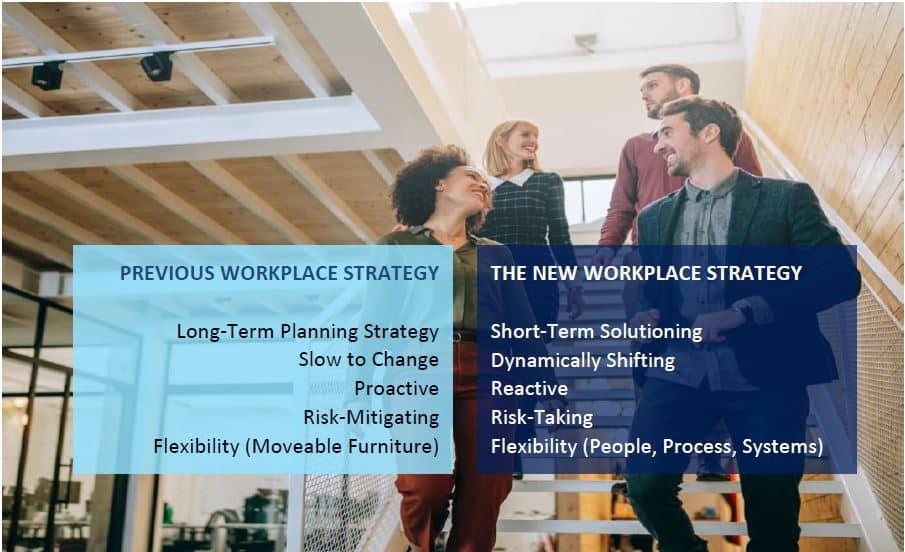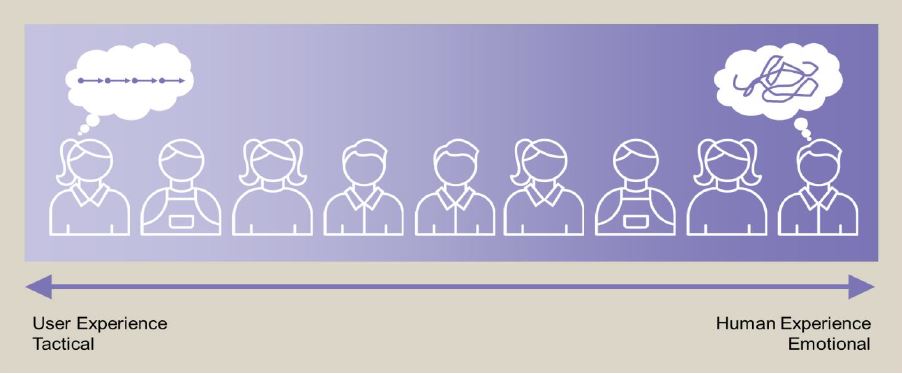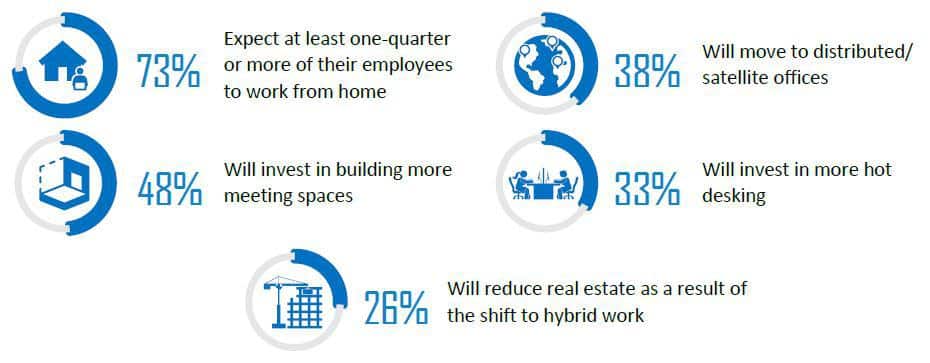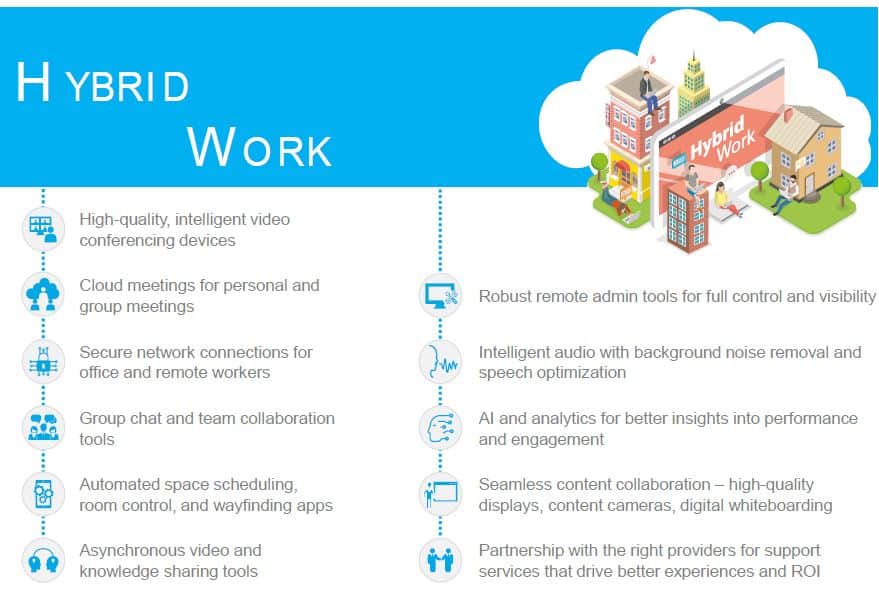
Today’s guest author is Roopam Jain, Vice President of Research, Information and Communications Technologies at Frost & Sullivan.
Jain is focused on Unified Communications & Collaboration. She’s been leading strategic consulting and market studies for more than 22 years. Today, she’s focused on what hybrid work means to organizations and technology providers.
The concept of work—how we communicate, collaborate, create, and innovate—has changed forever. These are deep, structural changes to the nature of work and how and where it gets done.
Today’s hybrid work models, defined by a mix of time spent at home or office, have almost infinite variations. But what if work was just work? What if we could transcend current hybrid models and make work feel natural, engaging, and productive from anywhere? And what if workspace and workplace technologies enabled this effortlessly?
At the AVI-SPL Sales Acceleration Summit 2022, Frost & Sullivan joined a panel of industry experts from JLL and Steelcase. The panel discussed the re-envisioning of work that is creating new challenges for organizations and opportunities for technology providers to help solve them.
The conversation followed three main themes:
- people’s changing expectations of work
- the evolving workplace experience, and
- the role of technology in enabling these shifts.
The panel initiated an open dialog on the fundamental changes in the nature of work and concluded that businesses have massive opportunities to adopt a human-centric approach that boosts productivity and locks in better employee experiences. This paper shares the key takeaways for overcoming the challenges of hybrid work and creating long-term transformations that position businesses to succeed in the new future.
Hybrid work is riddled with complexities. Business leaders are facing several questions. What is the right mix of in-office and remote work policies that will boost productivity, creativity, and collegiality? How can businesses plan for office space and technology investments while the mix of remote and in-office presence is in flux? How can they maintain business continuity and pivot to remote work at short notice? How can they pilot new space and technology designs and measure the success of these transformations? And finally, how often should leaders revisit their work and workplace strategy?
While there are no straightforward answers, it is clear that agility and flexibility are becoming critical. Workplace strategies today are much more dynamic, fluid, progressive, and reactive. In addition, organizations that are developing a preeminent human-centric approach, focused on viewing employees as key stakeholders, will innovate, grow, and thrive. These companies are more agile and can better adapt to change.

Source: JLL
Defining human experience
Creating the best user experience has been an unwavering goal for the world’s most successful businesses. That includes an obsessive focus on creating products and services with a singular purpose—locking in users with strategies and product designs that are so compelling (maybe addictive) that they prevent users from going elsewhere. In this approach, companies focus on the tactical aspect where people are users of a product above all. It is centered on predicting user behavior – how people work, how they’re going to react, and what buttons they are going to push.
Human experience, on the other hand, takes a holistic view and goes beyond user experience by creating an empathetic lens. This approach treats employees, customers, and internal and external stakeholders as humans first.

Source: JLL
It took a pandemic for the world to realize the complexities of how people work and what their wants, needs, and expectations are. People are emotional, complex beings that are inherently unpredictable due to the constant impact of external influences. Businesses gearing up for the new ways of work must focus on making people, place, and technology decisions with a new goal of creating human experiences that lead to better business outcomes as well as happier and more engaged employees.
User experience primarily focuses on aspects of simplicity, usability, and frictionless experiences. As we move up the spectrum to a human-centric approach, the focus is instead on enabling experiences that allow people to make meaningful connections, have a sense of shared purpose, and achieve outcomes aligned with their beliefs, values, and emotions versus simply trying to accomplish tasks in the fastest and most efficient way.
Three Pillars to Creating a Human-centric Organization
Source: Frost & Sullivan
Decoding hybrid work with a focus on people
Moving forward, organizations should not expect work dynamics to revert to the pre-COVID-19 environment. Instead, companies planning to return to the office need to embrace a hybrid approach. In a global survey of business leaders and IT decision-makers, a dominant 73% of organizations responded that at least 25% or more of their employees will work from home on a part-time or a full-time basis in the future.
To accommodate the changing needs of their employees, 38% of the organizations plan to build out distributed or satellite offices and 33% report that they will increase the use of “hot desking,” the practice of having multiple workers use the same desk at different times.
Workplace 2022: Investment Priorities

Source: Frost & Sullivan Annual Survey, Communications and Collaboration Investment Priorities, April 2022
Today, businesses of all sizes are in the process of planning for long-term transformations. However, with many variations of hybrid work still evolving, no one quite agrees on the right mix of in-office and remote work and how to precisely plan for the future. The hybrid model means different things to different organizations, and many organizations are experimenting with their options. Planning, executing, and measuring the efficacy of all changes will be an iterative process until businesses are satisfied with the outcomes, and ultimately, the best-fit mix will be largely dependent on a company’s specific culture, user personas, availability and location of office space, as well as the nature of their business and work processes.
The pandemic revealed that employees can be equally, if not more, productive when working from home. Many employees are placing a premium on flexibility and are simply unwilling to go back to the office full-time. When their expectations are not met, they are even willing to leave their jobs. According to the US Bureau of Labor Statistics, more than 4.3 million people voluntarily quit their jobs in February 2022, slightly below a record high in November 2021. Offering flexible work options is not a choice, it’s a must. And it helps businesses tap into massive opportunities and hire from a global pool of anytime, anywhere talent while reducing costs.
One of the most difficult aspects of remote work is fostering meaningful connections, apprenticeship, and collegiality which can potentially impact creativity and innovation. In a Frost & Sullivan survey, when asked about the top challenges employees experience with remote work, a third of the respondents cited concerns about the negative impact on relationships with coworkers and on building business culture and mentorship.
So how can we work from anywhere and collaborate seamlessly at the same time? The answer lies in investing in cutting-edge technologies that bring together remote and on-site teams. With the right tools and their correct implementation, remote work and the ability to make meaningful human connections are no longer opposing ideas. Investments in good quality audio, video, group chat, and ideation/content collaboration technologies are already patching this gap for millions of businesses. While it does not completely replace the need for in-person interactions and the serendipitous conversations, it supports the evolving workstyle choices of a hybrid workforce.
Designing the New Workplace for Collaboration
As businesses prepare for hybrid work, office spaces are getting a makeover as well. Workplace redesign is centered on the notion that the physical office is more relevant than ever before to bring people back together. Offices are turning from plain technology-devoid spaces to new vibrant, collaboration-rich environments not only equipped for the constant ebb and flow in employee numbers but also enabled to seamlessly connect dispersed teams.
Businesses are investing in newer types of spaces—hot desks, open collaboration spaces, meeting pods, flex work areas, huddle rooms, think spaces, work cafés, open-air spaces, and communal information areas. In addition, as work teams get more distributed and dispersed there is a growing need for more meetings and more meeting rooms. The common theme across all workspaces is that they are designed to energize employees and promote creativity and collaboration. Therefore, investing in a technology-driven hybrid work environment is a must.
Key Technology Initiatives for the Hybrid Workplace

Source: Frost & Sullivan
A successful workplace redesign requires a thoughtful and comprehensive plan that spans new technology implementation, real estate optimization, and change management spearheaded by HR to ensure the best hybrid work experience. It is critical that steering committees keep all stakeholder views and preferences in mind and are built of cross-functional teams of C-suite, IT, HR, facilities, line of business heads, and user groups.
The design process typically involves planning, piloting, testing, and modifying before implementing at scale. JLL, a global leader in real estate services, is helping its clients navigate the complexities of building the hybrid office space with its Experience/Spaces initiative that allows clients to go from concept to design to build-ready quickly and cost-effectively. Using modern software and services, JLL enables 3D space visualization to create virtual spaces, including different renderings, allowing users to experience walkthroughs for concept testing. Instead of taking weeks to develop the physical pilot, customers can implement a virtual space plan in hours and show ideas to users for feedback on preferences and choices. In addition, these pre-design space concepts can embed social media capabilities and gamification that allow people to interact with the images, spaces, and videos to provide instant feedback on the new design.
User testing is critical because it saves time and resources and helps build spaces that best meet the needs of the hybrid workers. Using a mix of third-party social feedback tools and, software that creates 3D visualizations and VR spaces, JLL is accelerating the transformation of traditional office spaces into sought-after hybrid work destinations. Ultimately, it is the users that will determine what works and what does not work.
Driving Inclusive and Engaging Hybrid Interactions
Mass adoption of video meetings, chat, virtual whiteboarding, and group messaging has kept remote workers productive and fully connected over the past two years. Everyone has the same presence and an equal voice during virtual meetings. In this digital experience, employees have found a new parity and power. Moreover, meeting chat gives all employees a chance to voice their thoughts, even those who are otherwise shy or uncomfortable speaking up in large in-person meetings.
Hybrid meetings change the stakes for all. Remote participants in a hybrid meeting feel the disparity. They are at a disadvantage as they settle for compromised audio, video, and content collaboration experiences leading to unproductive and unengaging meetings. Similarly, those present in the meeting room miss out on personal interactivity such as private and public chat, raising hands, live reactions, meeting transcription, and translation.
So, what needs to change and how can we get there? The answer to these challenges is to reevaluate the meeting room from a new perspective that focuses on engaging, inclusive, and equitable experiences. We simply cannot go back to the old meeting rooms.
Recent enhancements in meeting services and device features are driving audio-video parity to address the concerns around equitable meetings while giving managers more visibility and control into remote work.
Creating meeting equity hinges on three main areas:
- Equitable Audio – Audio is a huge focus for hybrid workstyles. Background noise removal combined with advanced speech optimization and customization enables users to have better meetings while allowing them to personalize their experience depending on their location. This prevents remote users from bringing unwanted noise into meetings. Similarly, remote participants can clearly hear people in a meeting room no matter how far they are located from the audio source.
- Inclusive Video – Advanced camera sensors and smart video framing create immersive and inclusive experiences. Modern cloud meeting platforms are working in conjunction with camera vendors to use advanced AI-powered technologies that detect people in a room, individually reframe participants, and create video streams for each. This helps eliminate traditional bowling alley views that remote participants get and allows showing room participants in individual boxes on the screen for an optimized experience. In addition, multi-camera support and camera switching enable better views of all participants in a large room.
- Engaging Content Sharing – The addition of content cameras to meeting rooms enables remote attendees to clearly view far-end content. New presenter view modes add an overlay of the presenter’s video within the presentation channel, enabling more engaging presentations where the audience doesn’t have to choose whether to focus on the presenter or the content. Lastly, integrations with digital whiteboarding apps and a focus on linking together the digital and physical experiences put everyone on the same page when it comes to contributing ideas.
Call to action
To get the best outcomes from the human-centric organization and enable an elegant shift to the new workplace, businesses must implement a comprehensive, user-centric change management program.
- Understand the unique needs of your employees – When it comes to hybrid work strategies, one size does not fit all. Support the shift with a clear understanding of user preferences as well as their concerns and needs for the new workplace. Plan, pilot, test, and readjust spaces and technology options based on the needs of all stakeholders, including employees.
- Train and implement for success – Ensure optimal technology and resource utilization by training users adequately. Get employees excited about and engaged in workplace design changes by holding open houses and showcasing the benefits of an agile workplace.
- Build support groups – Build a peer-to-peer collaboration culture to keep employees motivated and engaged. Conduct frequent check-ins on employee well-being resulting from workplace changes. Create support groups and assign mentors who can assist employees with their workplace and technology support needs.
- Leverage a comprehensive technology stack – Invest in an end-to-end collaboration stack that covers the gamut of next-gen tools, including modern audio, video, content collaboration, asynchronous collaboration, and messaging, to bridge the gap between in-person and virtual teams.
- Put people first for equity and inclusion – Eliminate disparities between locations and people by investing in spaces and technologies designed for the most equitable and inclusive experiences.
- Leverage the power of data-driven insights and AI – Data and analytics that measure the well-being and happiness of employees and offer deep workplace insights result in the most successful digital transformations. Rich analytics and insights on user behavior and technology use enable a better assessment of what is working and what needs to change.
- Partner with leading managed and professional service providers – Choose a provider that is aligned with your business needs and offers a comprehensive set of support and professional services, including design, integration, monitoring, and management of your hybrid workforce technologies.

